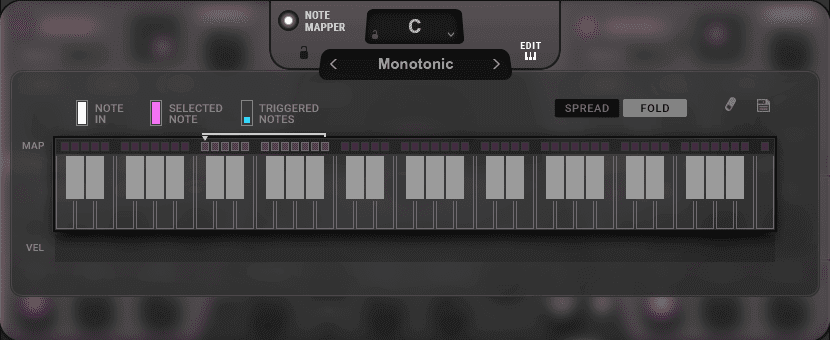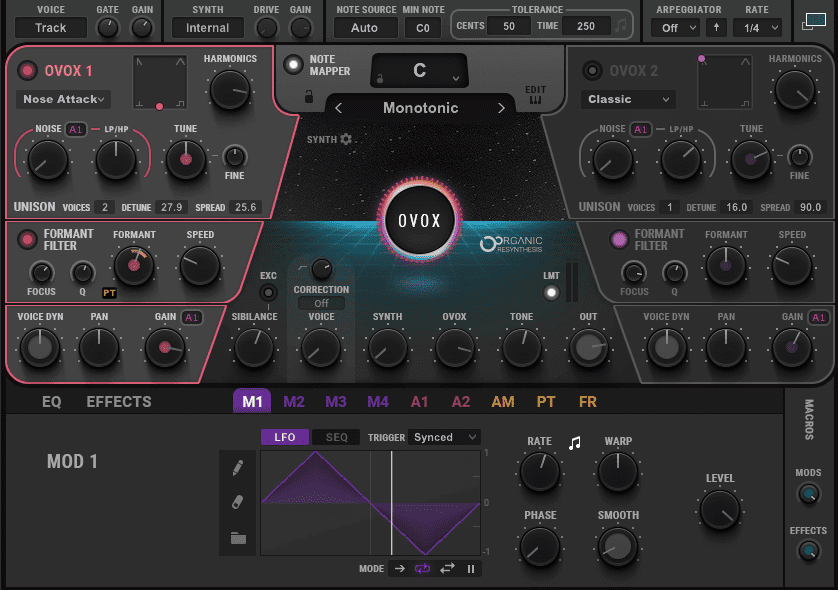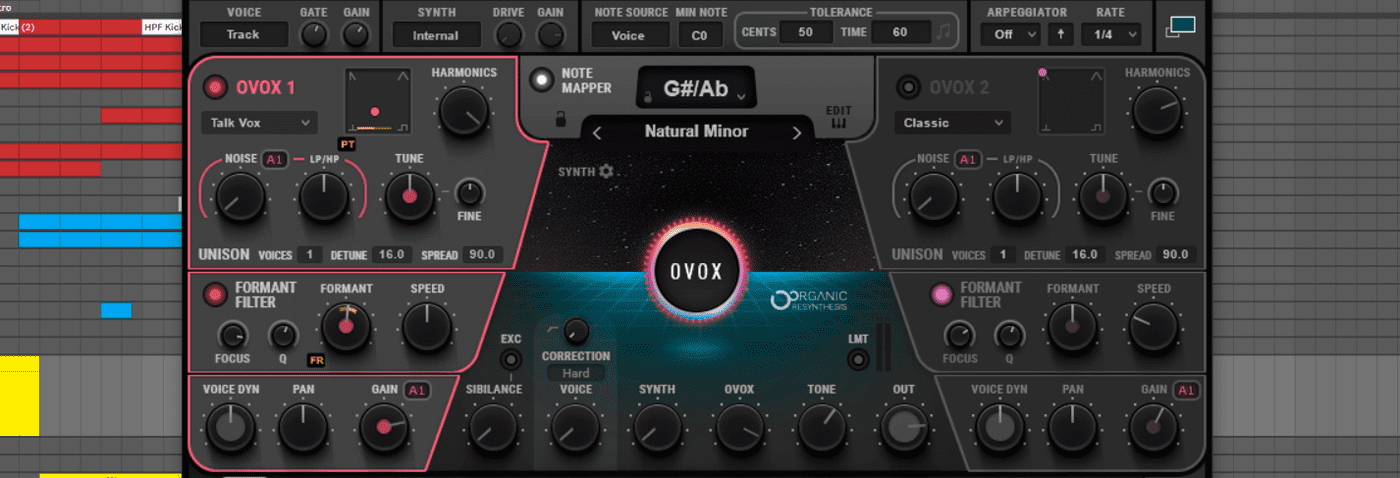This plugin from Waves wants to be your go-to vocal processor. Is it more than just another vocoder?
Ovox Vocal ReSynthesis, Waves’ new plugin, is more than just your run of the mill vocal processor. Need a vocoder? Ovox can do it. Vocal harmonizer? Sure, no problem. How about pitch correction? Yeah, whatever you need, fam. Ovox Vocal ReSythesis (to use the full name) can do all this and more—and gorgeously. This is definitely not your father’s vocoder. Whereas back in the day you could really only make robot or synth pad vocals, with Ovox pretty much the sky’s the limit.
The Overview
Ovox breaks down the incoming signal (usually voice but really anything will do the trick) into a number of constituent parts using what Waves calls Organic ReSynthesis (OSR) technology. It’s this resynthesis system at the heart of the plugin that allows Ovox to accomplish an astonishing variety of different processing tasks. The incoming signal is atomized into amplitude (volume), pitch, and formant parts. These are then resynthesized into a clean signal, with all of its elements available to be modified and modulated. The incoming signal (called a modulator when processing vocals) can be used to affect the two built-in synthesizers (or carriers). Pitch and note information can also be pulled from the incoming signal or overridden entirely with MIDI information. Sounds complicated? In practice it really isn’t.
Ovox can load into a DAW either as an effect on an audio channel or as a MIDI instrument. (It can also be run in standalone mode for live applications.) Depending on how you have the plugin set up, vocal audio will enter the plugin directly or via sidechain. The carrier signal can come from either the built-in synths or via a sidechained external source, such as hardware synth, separate plugin, or even guitar or drums. While this makes Ovox extremely flexible, routing can be a little confusing but thankfully there are walkthroughs available on the Waves support site.
The main view of the plugin, which you see when first launched, is broken up into three major sections, with routing and other information across the top bar, controls for the two synthesizers and note map harmonizing options in the middle, and macros and general volume and tone shaping knobs in the bottom mixer section. Click in the upper right corner to reveal the expanded view, which unveils more controls for the synthesizers as well as modulation, EQ, and effects sections, which drop down from the bottom. Lastly, the note map editor can be accessed from the harmonizer section.
The Synthesizers
The majority of the sound processing happens in the two eight-voice polyphonic synthesizer sections. The incoming signal passes through them in serial, although they can be turned off individually. Each synth has an oscillator with blendable waveforms (saw, triangle, square, spike) and 12 filter IR presets. As Ovox is meant for vocal processing, these tend towards your usual vocoder styles (from robotic to heavenly), although there’s nothing stopping you from using Ovox as just a synthesizer if you like. Additional controls include harmonics, tune, unison mode, and noise for breathiness.
Next the signal is routed through the formant filter, which is a key component in vocal processing. This analyzes the “vocal” elements of the modulator signal and applies it to the carrier, effectively imprinting the singer’s vocal tract movements onto the synthesized sound. Formant action can be focused narrowly or broadly, and the resulting signal can be shifted up or down for male or female vocal styles. The formant filter can be further modified with speed and dynamics controls for more (or less) realistic effects.
The mixer section allows the different signals—clean voice, synth, and Ovox processed signal—to be blended together. Sibilance can be adjusted to make the signal more intelligible. Pitch correction can be applied to help keep the clean vocal signal in line, harmonically speaking. It’s too broad to replace Autotune but it’s a welcome addition. Lastly, a tone dial functions as a tilt filter to emphasize the brightness or fatness of the signal.
The Note Mapper
Ovox has a sophisticated pitch and harmonizing section called the Note Mapper. Pitch information can be pulled directly from the signal, applied via MIDI, or derived from a combination of both. Chords, harmonies, and scales can be triggered automatically from the vocal information. The applications for this are almost endless, from instant harmonies for backing vocals, or something more experimental and esoteric. There’s also an arpeggiator to add striking pitch-related movement. And, if that weren’t enough, Ovox can generate MIDI out information, meaning you can create new melodies and phrases based on the incoming vocal signal.

Modulation and Effects
Any modern plugin worth its salt is going to have a number of assignable modulation parameters, and Ovox is no exception. There are nine modulators, including two ADSR envelopes, four LFO and step sequencer slots, and even modulators based on the OSR technology, namely amplitude, pitch, and formant information. These can be freely dragged to most any parameter in the synth. And, as with other recent Waves plugins, available destinations become highlighted when dragging, making it easy to see where to drop your modulator.
Anyone who has used a vocoder will know that EQing is a crucial part of achieving a usable signal. The human voice occupies a fairly limited band in the midrange part of the EQ spectrum, while a synthesizer can push out almost any frequency. EQing, then, can help sculpt the vocoded sound to fit better into a mix. Ovox has two EQs for doing just this. However, each of the four bands can be modulated, meaning you can use the EQs as moving effects as well.

Speaking of effects, Ovox includes six built-in stomp boxes that can be slotted into five spaces in an effects rack. Effects include autopan, chorus, compressor, delay, distortion, and reverb. These can be freely re-ordered and, as you would expect from Waves, they are uniformly excellent sounding.
Final Verdict
Ovox is competitive for software of this caliber. It’s only real competition in terms of breadth of vocal processing is iZotope’s VocalSynth 2 ($199), which does many of the same things though with a different workflow.
Waves Ovox Vocal Resynthesis is a deep and inspiring vocal processor that reveals more with each use. Not only can it be your new favorite vocoder, it’s great for processing drums and other percussion sounds, for sound design, or even as a unique synthesizer. You can use it to generate harmonies and new melodies based on input pitch information. It’s exciting and experimental and we can’t recommend it enough. In a word: essential.
The Verdict
Purchase: Waves OVox
The Final Word
Whereas back in the day you could really only make robot or synth pad vocals, with Ovox pretty much the sky’s the limit.
